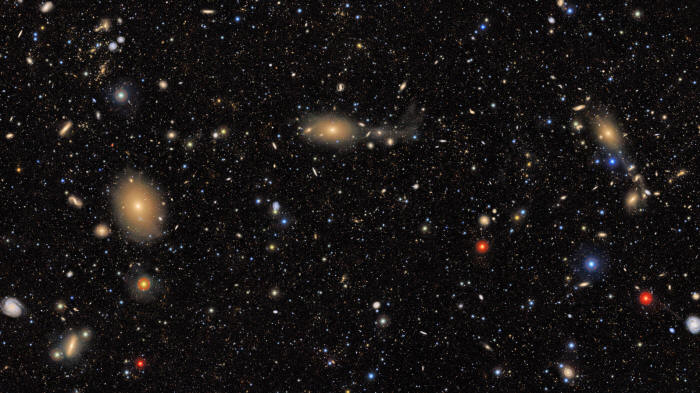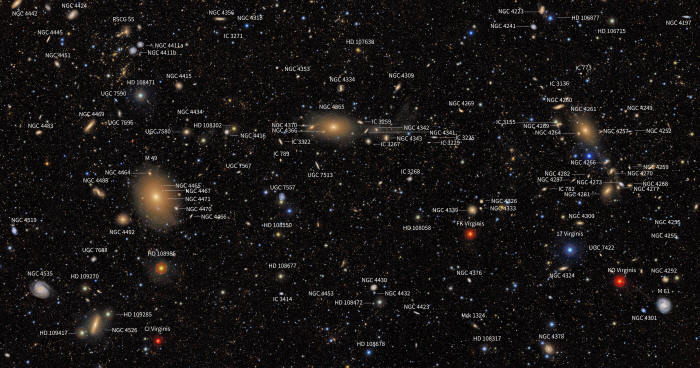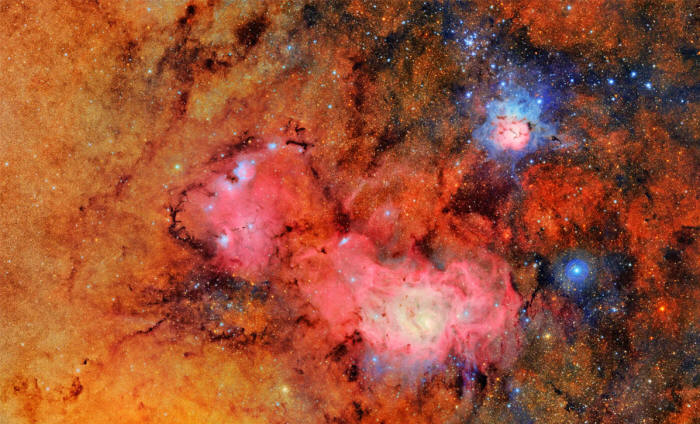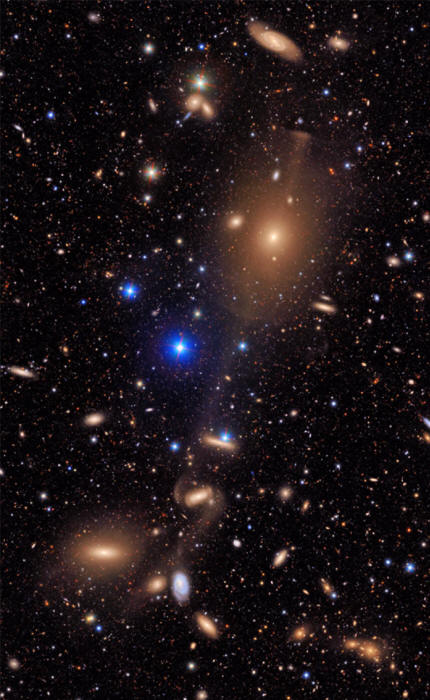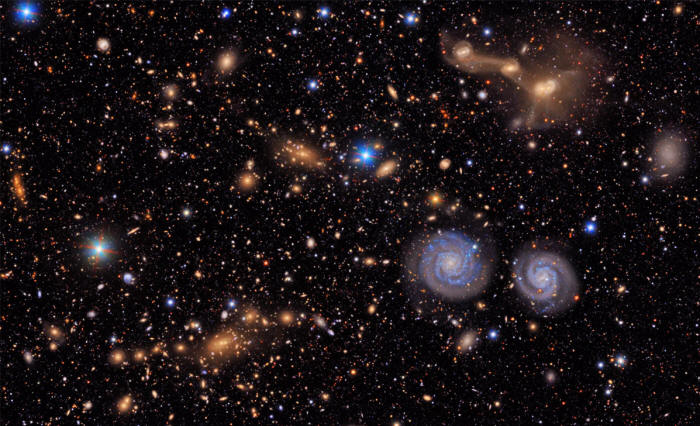|
shows a stunning variety of objects - from bright stars ranging from blue to red, to nearby blue spiral galaxies, to distant red galaxy groups - demonstrating the broad range of science made possible by Rubin data.
(Image credit:
RubinObs/NOIRLab/SLAC/NSF/DOE/AURA) astro-cinematography"...
From its perch atop Cerro Pachón in Chile, a mountain that rises around 5,200 feet (1,600 meters) above sea level, Rubin scans the entire night sky over the Southern Hemisphere once every three nights.
This endeavor will be the most extensive continuous mapping of the southern sky ever attempted, and will be conducted by Rubin using the 8.4-meter Simonyi Survey Telescope and the LSST camera (LSSTCam), the largest digital camera ever constructed at around the size of a small car.
Video
Just one image from the LSSTCam covers an area equivalent to the size of 45 full moons in the sky.
Above is the observatory's first image of the Virgo cluster, a vast cluster of galaxies located around 53.8 million light-years from Earth. The image shows a vast array of celestial objects, including galaxies and stars.
Demonstrating the true potential of Rubin, this image alone contains a rich tapestry of about 10 million galaxies.
Staggeringly, the ten million galaxies in the above image are just 0.05% of the number of around 20 billion galaxies that Rubin will have imaged by the end of the LSST.
In fact, in a decade, Rubin will have collected data on an estimated 40 billion celestial bodies, meaning we will have seen more heavenly bodies than there are humans alive for the first time.
Unsurprisingly, many of these objects are completely new and viewed by humanity for the first time today.
The objects that are familiar have been highlighted in the image below:
An annotated version of the Rubin image showing some of the 10 million galaxies captured in the observatory's first image. (Image credit: RubinObs/NOIRLab/SLAC/NSF/DOE/AURA)
Video
If it Moves, Rubin will See It
One of the most impressive abilities of Rubin will be its capability to study objects that change in brightness over time as it builds the "greatest movie of all time."
This unique power comes from the fact that Rubin can scan the sky at superfast speeds, around 10 to 100 times faster than similar large telescopes.
The "transients" it sees will include over 100 million variable stars changing their brightness because of pulsations, thermal instabilities, and even because of planets "transiting," or passing between Rubin and their visible disks.
Rubin will also be able to observe millions of massive stars as they end their lives and undergo supernova explosions.
The groundbreaking observatory will also investigate so-called "type Ia supernovas," triggered when dead star-white dwarfs undergo runaway nuclear explosions after overfeeding on stellar companions.
Type Ia supernovas are also known as "standard candles" due to the fact that their consistent luminosities allow astronomers to use them to measure cosmic distances.
Thus, Rubin will also make an indirect impact on astronomy by providing scientists with a wealth of new and better-understood distances between objects in the universe.
Closer to home, by observing objects as they change in brightness in the night-sky, Rubin will provide astronomers with a better picture of asteroids and small bodies as they orbit Earth.
This could help space agencies like NASA assess potential threats to Earth and defend against asteroids.
The YouTube video below shows over 2,100 new asteroids discovered by Rubin in its first week of operations alone.
https://www.youtube.com/watch?v=JrmISbL4yC4
Rubin's Power lies in the Details
Hours before the release of the main images above at 11 a.m. EDT (1500 GMT) on Monday (June 23), the Rubin team released several smaller "preview" images that are smaller sections of these larger images.
These give the general public an opportunity to witness the incredible detail in images captured by the LSST camera.
The image below shows the Triffid nebula (also known as Messier 20 or NGC 6514) in the top right, which is located around 9,000 light-years from Earth, and the Lagoon nebula (Messier 8 or NGC 6523), estimated to be 4,000 to 6,000 light-years away.
These are regions in which clouds of gas and dust are condensing to birth new stars.
This image combines 678 separate images taken by NSF-DOE Vera C. Rubin Observatory in just over seven hours of observing time. Combining many images in this way clearly reveals otherwise faint or invisible details, such as the clouds of gas and dust that comprise the Trifid nebula (top right) and the Lagoon nebula, which are several thousand light-years away from Earth. (Image credit: NSF-DOE Vera C. Rubin Observatory)
The above picture combines 678 separate images taken by Rubin over just over 7 hours of observing time.
By combining images like this, Rubin is capable of revealing details otherwise too faint to see or practically invisible. This reveals the clouds of gas and dust that comprise these nebulae in incredible detail.
The image below shows a small section of Rubin's total view of the Virgo cluster.
The bright foreground stars in this image are located closer to home, lying in the Milky Way. In the background are many galaxies even more distant than the Virgo cluster.
This image shows a small section of NSF-DOE Vera C. Rubin Observatory's total view of the Virgo cluster. Bright stars in the Milky Way galaxy shine in the foreground, and many distant galaxies are in the background. (Image credit: NSF-DOE Vera C. Rubin Observatory)
The image below shows another small slice of Rubin's total view of the Virgo cluster.
Visible in the lower right of the image are two prominent spiral galaxies. In the upper right of the image are three galaxies that are colliding and merging.
This image shows another small section of NSF-DOE Vera C. Rubin Observatory's total view of the Virgo cluster. Visible are two prominent spiral galaxies (lower right), three merging galaxies (upper right), several groups of distant galaxies, many stars in the Milky Way galaxy and more. (Image credit: NSF-DOE Vera C. Rubin Observatory)
The image also contains several other groups of distant galaxies, as well as a wealth of stars in our galaxy. It is just one 50th of the entire image it came from.
Following the release of these images, the next big step for Rubin with be the beginning of the LSST, which should occur over the next few months.
Bonito added that,
And with 10 years of the LSST ahead of it, the future of Rubin and astronomy in general is bright.
To dive into the first image from Rubin and explore for yourself, visit the Vera C. Rubin Observatory SkyViewer page.
|


